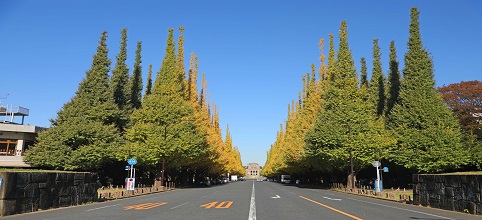2023/08/02
Trees to be Cut Down for the Jingu Gaien Redevelopment Project; The City Planning Process Now Needs to be Reviewed

On June 25, Haruki Murakami, novelist, referred to the redevelopment project of Jingu Gaien on a radio program he hosts and said, “I want the government to keep the greenery as it is. Once something is destroyed, it cannot be restored.” This project includes the demolition and reconstruction of the current Jingu Stadium and Chichibunomiya Rugby Stadium, as well as the construction of several 180 to 190-meter-high skyscrapers. The government aims to complete the project in 2036. The demolition of the Jingu Secondary Stadium has already started in March this year, and the comment by Murakami was made as he knows about tree cutting that will finally begin along with the removal of steel beams at the ballpark.
The focus of this concern is the cutting of trees that have to be done to carry out the construction work and the preservation of the gingko trees in front of the Meiji Memorial Picture Gallery. The tree removal company originally planned to cut down 971 trees, but eventually reduced the number to 556, and said that they would continue to consider the possibility of transplanting and planting trees, and the Tokyo Metropolitan Government agreed to this plan in August 2022. Nevertheless, there are also strong voices calling for the cancellation of the plan. International Council on Monuments and Sites (ICOMOS) Japan announced a statement requesting a review of this redevelopment project, and the number of signatures opposing the project by the residents of Tokyo had reached 195,000 by May 2023. It is also still fresh in our memory that Ryuichi Sakamoto, a famous composer who passed away this March, sent a letter to the governor of Tokyo and heads of related administrative offices, stating that he did not want the trees that his predecessors had spent 100 years protecting and growing to be cut down.
The primary problem lies in the way the project has been and will be carried out. The redevelopment project started behind the scenes in 2013, just after Tokyo was selected as an official candidate to host the 32nd Olympics. The Tokyo Metropolitan Government has been creating the path to the large-scale redevelopment project in phases. They cancelled the designation of the Jingu Gaien area as a scenic area that prioritizes the preservation of the natural landscape upon land utilization. They also established the “system for development of parks and surrounding communities” that allows redevelopment of an area by discontinuing the designation as a city planning park. There are certainly no procedural flaws. Nevertheless, the details of the plan were not announced publicly until the end of 2021, which means that the opportunity for the citizens of Tokyo to participate in the formulation of the city plan was substantially eliminated.
Today, the public benefit and profitability are no longer simply seen as two opposite elements. The government’s strong statement, “Legally, there is no problem.”, is also outdated. The role of the government is to provide fair and open structure of consensus building, and I hope that they will make an appropriate decision to avoid future problems.
It is also said that the redevelopment project aims to “pass on the legacy of the Tokyo 2020 Olympic and Paralympic Games” to the next generation. It makes sense. I remember that, at a sporting goods manufacturing company, I was shown a part of the dismantled track of the old National Stadium. There was a 100-meter dash starting line that had been cut off. The government, who promptly dismantled the valuable “cultural heritage” symbolizing post-war rehabilitation and recording the history of the sports culture in Japan without further discussions on the possibility of renovation, should not talk about the “legacy”! Such anger came to my mind while writing this column.
This Week’s Focus, June 30
Takashi Mizukoshi, the President